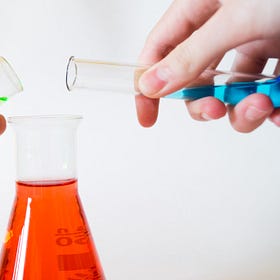The Biochemical Energy That Our Bodies Need, Explained.
Who would have thought that the energy generation process in our bodies was actually that complicated?
It is a common sight to see people slumped over or being one with the floor at the end of an exhausting workout. The inertia becomes too much to overcome. It’s difficult to stay up straight. If you’ve been in that position before, there are days when you would very much prefer to remain in that horizontal position rather than get up and get washed up. I’m not laughing at anyone, I’ve personally been in that state quite a few times myself.
The problem is that our bodies somehow tend to change as we get older. We can’t seem to do what we did at age 35 compared to when we were 25. We can’t stay up that late — we need sleep. We can’t maintain our stamina or energy levels when participating in a group sport activity.
We tend to blame our lower energy levels on “aging” or “getting older”, but a lot of that can be pinpointed on the maintenance that we provide to our bodies. LeBron James can play professional basketball at a high level even at age 40 because of all the time and money that he spends on proper maintenance and recovery.
Unfortunately, most of us don’t have access to that much money for survival, let alone take care of our physical health as immaculately as he can for himself.
But it’s more likely that we’ll go for a run, get ourselves tired out, and then reward ourselves with ice cream or some other sweet treat for doing all that hard work, and in doing so just unravel whatever work that we’ve put into that workout.
But how do our cells even gain energy to get our bodies moving about in a workout?
The answer lies in this molecule known as acetyl-coenzyme A (acetyl-CoA). Acetyl-CoA can be obtained from glucose, fatty acids or amino acids that we feed ourselves with. The cell operates the tricarboxylic acid (TCA) cycle to oxidise acetyl-CoA within their mitochondria, and from there this molecule known as adenosine triphosphate (ATP) is formed.
When acetyl-CoA gets shuttled into the TCA, both the reduced form of nicotinamide adenine dinucleotide (or NADH) and the reduced form of flavin adenine dinucleotide (or FADH2) are produced as byproducts of the oxidation reactions going on within the TCA.
These NADH and FADH2 molecules are then oxidised by the electron transport chain. Electrons are removed from NADH (to form NAD+) and FADH (to form FAD), and the electrons are transported along the chain by Coenzyme Q10 (CoQ10). Protons are pumped from the mitochondrial matrix to the intermembrane space to form a proton gradient, and the electrons are finally used to reduce molecular oxygen to water.
What's The Deal With CoQ10 In Our Bodies?
A majority of the human population in today’s modern society is tired and overworked. I feel like that too sometimes - there are all these deadlines at work to meet, mortgages to pay, and the crises that comeseem to be neverending.
In the mitochondria, the ATP synthase enzyme then makes use of the proton gradient to synthesise ATP.
This process of ATP synthesis is known as oxidative phosphorylation (OXPHOS). As the word “triphosphate” suggests, there are three phosphate subgroups in ATP. The cleaving of a phosphate group from ATP is the process that releases biochemical energy for the cell to make use of.
Hence, ATP is referred to as an energy currency for the cell to use.
But we do realise that for the energy flow in the body to function at its best, we have a few factors to consider:
The effectiveness of the electron transport reactions.
The transport of molecular oxygen to the cell (which is dependent on our lung capacity and our respiration rates).
Electron leakages aren’t really that good for us at all, because it’s just going to cause unwanted oxidation somewhere else in the body.
Unfortunately, as we age, the mitochondria tend to face higher levels of mitochondrial dysfunction. Mitochondrial dysfunction results in the production of a greater amount of reactive oxygen species (ROS), which are highly reactive and pro-oxidation - that’s when the electrons that are supposed to reduce molecular oxygen into water leak out elsewhere.
As it is said in this book,
superoxide is the primary oxygen free radical produced in mitochondria via the slippage of an electron from the ETC to molecular oxygen during OXPHOS.
Superoxide is formed when an electron leaks out of the ETC. Superoxide is also a highly reactive ROS that can react with just about anything and oxidise it.
But the important point to note is: When the electrons are leaking out, then how much less ATP are we producing, and how much more ROS damage is our body going to sustain?
Therefore, how much less energy do we have available for use? How does that contribute to our energy and stamina levels on a day in, day out basis?
Because that would wreak havoc on the redox balance in our body, which could ultimately culminate in the development of oxidative stress if we don’t do anything to mitigate that problem.
Oxidative Stress Is An Electrochemical Concept That Focuses On An Inappropriate Rate Of Electron Transfer.
The electron is a particle that is responsible for transporting electric currents. Whenever we flick a light switch on at home, we’re connecting up a circuit that allows for the flow of electrons to power up a device that can then convert that electrical energy into light energy, such that our houses get illuminated.
That is not something that we want to develop in ourselves any time soon.
ROS neutralisation
One factor to consider in ROS neutralisation is from this antioxidant known as glutathione, which our cells are able to manufacture on their own.
Glutathione not only possesses antioxidant capabilities, but it also is able to perform detoxification on a wide range of harmful substances that could otherwise deal biochemical damage to the cells within our body.
GSH is a tripeptide molecule that contains 3 amino acids: cysteine, glycine, and glutamic acid. If we were to consume it orally or via an injection, it doesn’t do much. That is because the half-life of GSH in blood plasma is only at maximum a few minutes — meaning that it only takes that few minutes for the viable concentration of GSH to decrease by 50% in the blood plasma.
When we do consume it exogenously, we would have to realise that it doesn’t get continuously regenerated by the glutathione reductase enzyme, which is found within the cell and which aids in regenerating spent glutathione within the cell.
It is much better to stimulate the cells in our body to produce GSH endogenously, or within the cell.
Ironically, having a better ROS neutralisation capacity may help to improve our energy generation processes!
But when the glutathione levels in our body decrease over time, we’d be able to see the effects that it has on reducing our ability to generate energy. We’d find it more difficult to maintain our fitness levels.
But we’d end up seeing wrinkles on our skin first, too.
And when wrinkles are present, it’s inevitable that our stamina levels are going to drop.
The Biochemistry Behind The Aging Process
Aging is unfortunately an inevitable problem that all of us humans will face. Multiple aspects of our lives can be affected as we age.
But there’s always a way to slow it down, and that is via the nuclear respiratory factor 2 (nrf2) pathway - do read on below to find out more.
Antioxidant Protection In The Body Begins From Within The Cell.
Our body is constantly in a tug of war between reduction and oxidation (redox), which basically comprises multiple reactions where electrons are being transferred from one component to another.
Do feel free to share this article and hit the “subscribe” button to get more updates about the science concepts in nutrition and health, all deconstructed nicely for your convenient perusal!








